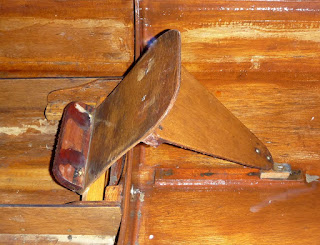The rower is Peter Miller of Sydney, with Mrs Miller in the back seat. He writes:
Many years ago my wife and I were exchange students to Japan so we were very much looking forward to our recent holiday there with the kids. The plan was to take it easy, meet up with some friends and do a bit of sightseeing. The two rowing experiences were of course just a bonus.
The first row happened by pure chance. As we went to the hot springs in Hakone we stopped briefly next to Lake Ashi (Japanese: Ashinoko) which was formed in the caldera of Mount Hakone after the volcano's last eruption 3000 years ago.When I saw boats were for hire I paid my 500 yen and with my wife took a quick sprint to the Toori (the red gate in the water next to the Hakone shrine). We knew it was going to be a memory that would last a lifetime and we were laughing all the way. We were especially lucky to see Mt Fuji through the clouds and have our friends capture the experience in a photo.
The second outing which was a row in the moat of the Imperial Palace in Tokyo was actually planned. Problem was I didn't know when the boatshed opened and my schedule was a little tight. When I arrived at the palace I captured some workers weeding the wall of the moat. As you can see Occupational Health and Safety considerations appear to be ignored when serving the Emperor.After a long walk I found the boatshed but it didn't open until 11am and I had a Bullet Train to catch early in the afternoon. It all turned out OK though - I woke a snoozing attendant and explained my predicament and he allowed me to get on the water a bit after 10. The Palace unfortunately is not surrounded by a single moat but a series of moats so you can't row all the way around but I was still able to have another decent sprint.Good times.CheersPeter
Thanks for that, Peter. I have been to Japan a few times but never managed to get out rowing. It is interesting to see that in a country with a huge range of fascinating types of indigenous boats made from wood with all the fastidious attention to detail for which the Japanese are famed, they still hire out rubbishy plastic tubs to tourists just like we do.


















